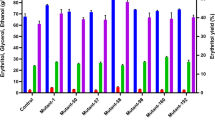Abstract
This study isolated a novel erythritol-producing yeast strain, which is capable of growth at high osmolarity. Characteristics of the strain include asexual reproduction by multilateral budding, absence of extracellular starch-like compounds, and a negative Diazonium blue B color reaction. Phylogenetic analysis based on the 26S rDNA sequence and physiological analysis indicated that the strain belongs to the species Pseudozyma tsukubaensis and has been named P. tsukubaensis KN75. When P. tsukubaensis KN75 was cultured aerobically in a fed-batch culture with glucose as a carbon source, it produced 245 g/L of erythritol, corresponding to 2.86 g/L/h productivity and 61% yield, the highest erythritol yield ever reported by an erythritol-producing microorganism. Erythritol production was scaled up from a laboratory scale (7 L fermenter) to pilot (300 L) and plant (50,000 L) scales using the dissolved oxygen as a scale-up parameter. Erythritol production at the pilot and plant scales was similar to that at the laboratory scale, indicating that the production of erythritol by P. tsukubaensis KN75 holds commercial potential.



Similar content being viewed by others
References
Barnett JA, Payne RW, Yarrow D (2000) Yeasts: characteristics and identification, 3rd edn. Cambridge University Press, Cambridge, UK, pp 1139–1142
Boekhout T (1995) Pseudozyma Bandoni emend. Boekhout, a genus for yeast-like anamorphs of Ustilaginales. J Gen Appl Microbiol 41:359–366
Cunha M, Firme P, San Romao MV, Santos H (1992) Application of nuclear magnetic resonance to elucidate the unexpected biosynthesis of erythritol by Leuconostoc oenos. Appl Environ Microbiol 58:2271–2279
Goossen J, Röper H (1994) Erythritol, a new sweetener. Confect Prod 24:182–188
Hanjny GJ, Smith JH, Garver JC (1964) Erythritol production by a yeast like fungus. Appl Microbiol 12:240–246
Hirata Y, Igarashi K, Ezaki S, Atomi H, Imanaka T (1999) High-level production of erythritol by strain 618A-01 isolated from pollen. J Biosci Bioeng 87:630–635
Ishizuka H, Wako H, Kasumi T, Sasaki T (1989) Breeding of a mutant of Aureobasidium sp. with high erythritol production. J Ferment Bioeng 68:310–314
Kim KA, Lee JK, Kim SY, Oh DK (2000) Optimization of culture conditions for erythritol production by Torula sp. J Microbiol Biotechnol 10:69–74
Kurtzman CP, Robnett CJ (1998) Identification and phylogeny of ascomycetous yeasts from analysis of nuclear large subunit (26S) ribosomal DNA partial sequences. Antonie Van Leeuwenhoek 73:331–371
Lee JK, Ha SJ, Kim SY, Oh DK (2000) Increased erythritol production in Torula sp by Mn2+ and Cu2+. Biotechnol Lett 22:983–986
Lee JK, Koo BS, Kim SY (2002) Fumarate-mediated inhibition of erythrose reductase, a key enzyme for erythritol production by Torula corallina. Appl Environ Microbiol 68:4534–4538
Lee JK, Jung HM, Kim SY (2003) 1,8-dihydroxynaphthalene (DHN)-melanin biosynthesis inhibitors increase erythritol production in Torula corallina, and DHN-melanin inhibits erythrose reductase. Appl Environ Microbiol 69:3427–3434
Lin SJ, Wen CY, Liau JC, Chu WS (2001) Screening and production of erythritol by newly isolated osmophilic yeast-like fungi. Process Biochem 36:1249–1258
Marina AYA, Glaucia MP, Park YK (1993) Microbial transformation of sucrose and glucose to erythritol. Biotechnol Lett 15:383–388
Motulsky HJ, Christopoulos A (2003) Fitting models to biological data using linear and nonlinear regression. A practical guide to curve fitting. Graphpad Software Inc., San Diego, CA
Munro IC, Bernt WO, Borzelleca JF, Flamm G, Lynch BS, Kennepohl E, Bar EA, Modderman J (1998) Erythritol: an interpretive summary of biochemical, metabolic, toxicological and clinical data. Food Chem Toxicol 36:1139–1174
Oh DK, Cho CH, Lee JK, Kim SY (2001) Increased erythritol production in fed-batch cultures of Torula sp. by controlling glucose concentration. J Ind Microbiol Biotech 26:248–252
Park JB, Seo BC, Kim JR, Park YK (1998) Production of erythritol in fed-batch cultures of Trichosporon sp. J Ferment Bioeng 86:577–580
Pfeifer VF, Sohns VE, Conway HE, Lancaster EB, Dabic S, Griffin EL Jr (1960) Two-stage process for dialdehyde starch using electrolytic regeneration of periodic acid. Ind Eng Chem 52:201–205
Pharr DM, Stoop JMH, Studer-Feusi ME, Wiliamson JD, Massel MO, Cokling MA (1995) Carbon partitioning and source-sink interactions in plants. In: Madore MA, Lucas WJ (eds) Current topics in plant physiology. American Society of Plant Physiologist’s, Rockville, MD, USA, pp 180–185
Roeper H, Goossens J (1993) Erythritol, a new raw material for food and non-food applications. Starch/Staerke 45:400–405
Ryu YW, Park CY, Park JB, Kim SY, Seo JH (2000) Optimization of erythritol production by Candida magnoliae in fed-batch culture. J Ind Microbiol Biotech 25:100–103
Seo JH, Ryu YW, Jung SR, Kim SY (2001) Fermentation processes for preparing erythritol by a high salt tolerant mutant of Candida sp. Patent US 6, 287,830 B1
Shindoh T, Sasaki Y, Miki H, Eguchi T, Hagiwara K, Ichikawa T (1988a) Determination of erythritol in fermented foods by high performance liquid chromatography. Shokuhin Eiseigaku Zasshi 29:419–422
Shindoh T, Sasaki Y, Miki H, Hagiwara K, Ichikawa T (1988b) Determination of erythritol in fruits and fermented foods by high performance liquid chromatography. Nippon Nogeikagaku Kaishi 62:623–626
Shindoh T, Sasaki Y, Miki H, Eguchi T, Hagiwara K, Ichikawa T (1989) Identification of erythritol by HPLC and GC-MS and quantitative measurement in pulps of various fruits. Agric Food Chem 37:1474–1476
Tokuoka K, Ishizuka H, Wako K, Taniguchi H (1992) Comparison of three forms of erythrose reductase from an Aureobasidium sp. mutant. J Gen Appl Microbiol 38:145–155
Van der Auwera G, Chapelle S, De Wachter R (1994) Structure of the large ribosomal subunit RNA of Phytophthora megasperma, and phylogeny of the oomycetes. FEBS Lett 338:133–136
Yoshida H, Sugawara T, Hayashi J (1984) Studies in free sugars and free sugar alcohols of mushrooms. Nippon Shokuhin Kogyo Gakkaishi 31:765–771
Acknowledgments
This work was supported by the 21C Frontier Microbial Genomics and Applications Center Program, Ministry of Education, Science & Technology, Republic of Korea.
Author information
Authors and Affiliations
Corresponding author
Rights and permissions
About this article
Cite this article
Jeya, M., Lee, KM., Tiwari, M.K. et al. Isolation of a novel high erythritol-producing Pseudozyma tsukubaensis and scale-up of erythritol fermentation to industrial level. Appl Microbiol Biotechnol 83, 225–231 (2009). https://doi.org/10.1007/s00253-009-1871-5
Received:
Revised:
Accepted:
Published:
Issue Date:
DOI: https://doi.org/10.1007/s00253-009-1871-5




